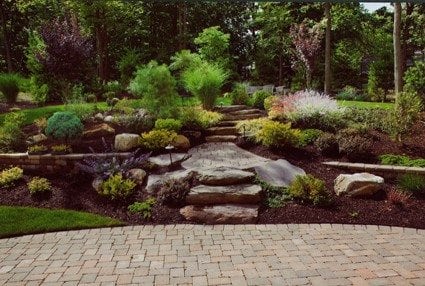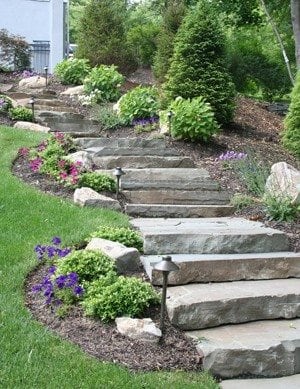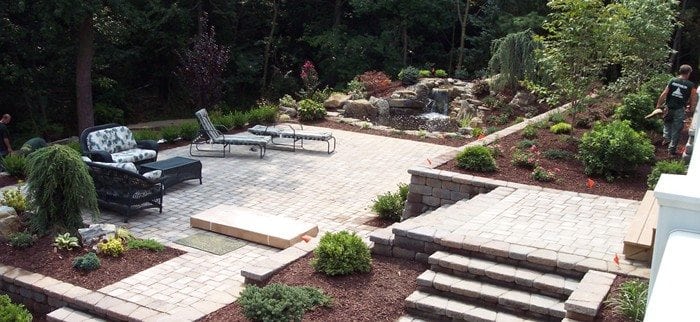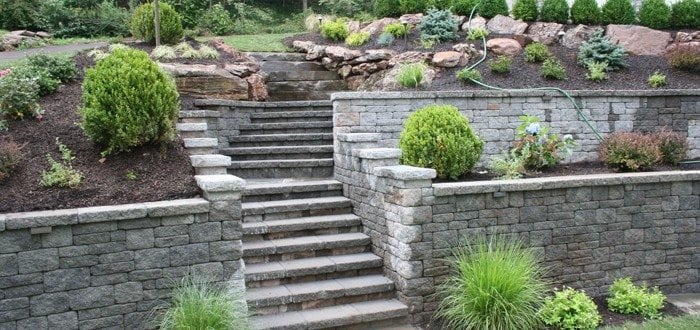Landscape design problems can be the cause for a lot of lost time and money if not solved correctly. Expectations and reality rarely ever seem to align and unfortunately when it comes to projects around the home, reality can be a heavy-hitter. Many of the most common landscaping problems that present themselves as causing the most depreciation to the land include landscape slope problems, water drainage, and erosion control.
Assessing your landscape for problem areas and creating solutions begins with understanding how specific terrains should be utilized and protected.
Hillside Landscaping

Many people buy property that has a hillside or slope because of the beautiful views that can be seen from the top but there are landscape architecture challenges that come with a hillside. Whether your hillside is in your front yard or a part of your backyard area, creating a design that addresses how to make that piece of land functional and able to flourish, can be difficult.
To begin the process, take a survey of the land and check for trees that may be hazardous on the incline as they mature and grow. Having a tree that will eventually uproot and fall is not safe and it will not add to your designs sustainability. Trees that are creating privacy or noise barriers should be carefully considered before removing since they add to your property’s worth.
Gradual cuts must always be made into a sloped landscape so that the least amount of earth is disturbed as possible. The disruption of too much soil will increase the likelihood of future erosion issues. If this applies to your home, here are some great hillside landscaping ideas to make it a functional and beautiful part of your property.
 Create Levels
Create Levels
If you are able to incorporate retaining walls then having varied levels throughout your hillside is a good way to define areas and make useful space. Place a patio or small seating area or add a garden with an arbor at the entrance for your own little peaceful hideaway.
Create a Path
Create a path with natural materials that correlate with your home’s décor. Stones and pavers are perfect for walkways and steps. If you have a large enough area, consider designing two paths, for entrance and exit, to add extra intrigue and usability in your yard.
Think Maintenance
Maintaining the landscape of a hillside can be more difficult that others terrains because of the incline and its tendency to have areas that aren’t easily accessible. Consider planting shrubs that cluster near walkways so that their greenery will disguise the need for edging.
Compacted Soil
Compacted soil can make it difficult to create a landscape design that will thrive and not be washed away before roots are able to creep their way deep into the earth. Dense soil resists moisture which can be an unproductive environment for vegetation because they are unable to receive the air and nutrients they need from the ground. In most cases, compacted soil happens because of many years of foot traffic stomping out air, causing the area to compress on itself. Below are three ways to remedy compressed soil for large, medium and small areas.
Aerate
Aerating is most helpful for large areas with compressed soil. An aerator punctures the ground leaving small cylindrical holes that allow air into the soil. Aerating is a great option for any type of soil rejuvenation process and can also ramp up the look and feel of your lawn.
Compost and Minerals
If you have a smaller area of landscape that has compacted soil, try adding organic compost materials to the mix. This will give your soil more air and nutrients for plants or grass to grow. Peat Moss and Gypsum are minerals that can be added into compacted soil to aid its ability to become nutrient rich and prosperous.
Earthworms
Specifically in a garden area, earthworms are a great way to bring new life to dirt! Earthworms dig their way through soil creating pockets of air which loosen and make room for water and nutrients to feed you flowers and vegetables.
Erosion Control

If you have a landscape with a hillside or large areas of compacted soil in your yard then you may experience issues due to runoff. Controlling the erosion on your landscape is a necessary part of ensuring that your plants will be able to root and that your hardscape is unable to shift. The following lawn care techniques can be used to solidify drainage issues and grow plants in otherwise unusable areas.
Grading
Grading has to do with the soil elevation in your landscape. When establishing a grade in your design it is important to remember that you will want water to move away from your home’s foundation and exit your lot towards a drainage system.
Retaining Wall
Retaining walls are excellent design features that can assist in decreasing the run-off and wearing away of a property. They can give large areas definition and act as a defense to erosion by allowing water to seep into stone and other porous materials when soil is compacted.
Hydroseeding
Hydroseeding is an option for homeowners that are struggling with getting grass to grow in areas that have problems with erosion. This process places a mixture of seed and mulch that solidifies the grasses ability to germinate and grow.
Standing Water Problems
If you don’t have water run-off problems in your landscape you may suffer from another kind of problem that homeowners encounter…standing pools of water. If even a light rain leaves a puddle of water somewhere in your yard then considering ways to incorporate methods of drainage is important. Standing water can lead to bugs, dead plant life and unusable space. The three ideas listed below are just a few of the methods that can be used to correct poor drainage problems.
French Drain
A French drain is a dug out trench containing a pipe and gravel. This type of drainage system is designed to redirect surface water away from your home or low lying areas. French drains are often seen near gutters but can be used anywhere through your landscape to alleviate excess water.
Dry Creek
This technique requires more work than others because it involves digging a fairly large trench. Design the trench with a natural look by adding curves and eliminating straight lines. Layers of large and small rocks must be placed throughout the trench to allow water to absorb easily into the ground.
Creating A Pond
If you have a large yard then creating a pond in an area that typically accumulates water is a way to design a specific drainage area and fashion an interesting focal point. Having a pond will afford your landscape unique vegetation and wildlife specific to its own ecology.
Landscaping Ideas for Problem Areas
If you have landscape issues with any or all of the problems discussed in this blog, then finding a solution is part of maintaining your property’s value. Seeking professional help for project and permit information is often a good idea when it comes to managing problem landscapes and creating a design that stands apart. Whatever your landscape problem is, Sponzilli Landscape Group can handle it!




